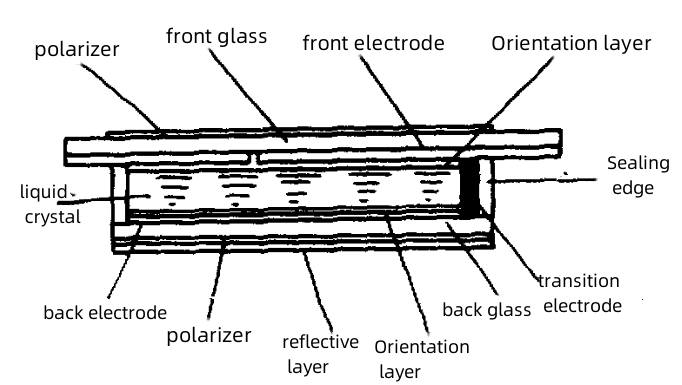Structurally speaking, liquid crystal display devices are flat-panel display devices, and their basic structure is flat-panel. All liquid crystal display devices can be viewed as consisting of two substrates photo-engraved with transparent conductive electrodes, with a liquid crystal layer sandwiched between them, and sealed into a flat box. If a polarizer is required, attach the polarizer to the outer surface of the conductive glass. A typical TN LCD device is mainly composed of large components such as polarizer, front glass, sealing edge, and back glass, as shown in Figure 1.

Two pieces of flat glass with photolithographic transparent conductive patterns are placed opposite each other with a distance of 6~7um. The surroundings are sealed with epoxy glue, and an opening is left on one side of the sealing edge. This opening is called the liquid crystal injection port, and the liquid crystal material is injected through the injection port under vacuum conditions. After injection, the opening is sealed with resin, and then the front and rear polarizers are orthogonally attached to the front and rear surfaces of the liquid crystal cell to complete a complete liquid crystal display device.
Liquid crystal display devices have three basic components, namely glass substrate, liquid crystal material, and polarizer. The following is a brief introduction to the use of these three basic components.
1)Glass substrate
The glass substrate is a thin sheet of float-produced glass with an extremely flat surface. A layer of indium oxide (In2O3) or tin dioxide (SnO2) is evaporated on the surface, and the transparent conductive layer is the ITO film layer. Transparent conductive patterns are made through photolithography. These graphics consist of pixel graphics and outer lead graphics. Therefore, the outer leads cannot be conventionally soldered and can only be connected through conductive rubber strips or conductive tapes. If scratched, cut or corroded, the device will be scrapped.
2) Liquid crystal material
Liquid crystal material is the main body of liquid crystal display devices, and different devices use different liquid crystal materials. Most liquid crystal materials are mixed from several or even dozens of single liquid crystal materials. Each material has its own fixed clearing point and crystallization point T. Therefore, liquid crystal display devices are required to be used and stored within a certain temperature range. If the temperature of use and storage is too low, crystallization will destroy the alignment layer of the liquid crystal display device; if the temperature is too high, the liquid crystal will lose its liquid crystal state, and the function of the liquid crystal display device will be lost.
3)Polarizer
Polarizer, also known as polarizer, is made of plastic film material. It is coated with a layer of optical pressure-sensitive adhesive that can be attached to the surface of the LCD cell. There is also a protective film on the surface of the front polarizer, which should be removed during use. Polarizers are afraid of high temperatures and high humidity, and will depolarize or bubble under high temperature and high humidity conditions.
Recommended related articles: